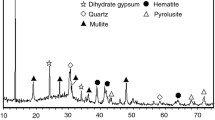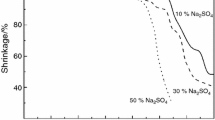Abstract
Electrolytic manganese residue (EMR) is a waste from electrolytic manganese industry that contains high concentration of toxic substances. Since the EMR disposal in landfill sites has a serious environmental impact, new ways of EMR utilization are being sought. Considering the melting of EMR to a glass at high temperature was a relatively less energy-intensive process, EMR was first made into a base glass and then the ground base glass was heat-treated in a certain procedure to make a glass-ceramic and the crystallization process was studied. It was determined by X-ray diffraction (XRD) that the primary crystalline phases of the EMR glass-ceramic were diopside and anorthite, which formed the surface crystallization mechanism with a crystallization activation energy of 429 kJ/mol. Scanning electron microscopy (SEM) observation showed that a layer of small spherical particles with an average size of about 0.5 μm were covered on the glass matrix surface, and among them there were some big particles. The low melting temperature and crystallization activation energy make it promising to reuse EMR for glass-ceramic production.
Similar content being viewed by others
References
L Barbieri, A C Bonamartini, I Lancellotti. Alkaline and Alkaline-earth Silicate Glasses and Glass-ceramics from Municipal and Industrial Wastes [J]. Journal of the European Ceramic Society, 2000, 20(14–15): 2 477–2 483
J Zhang, W Dong, J Li, et al. Utilization of Coal Fly Ash in the Glassceramic Production [J]. Journal of Hazardous Material, 2007, 149(2): 523–526
M Aloisi, A Karamanov, M Pelino. Sintered Glass-ceramic from Municipal Solid Waste Incinerator Ashes [J]. Journal of Non-Crystalline Solids, 2004, 345–346: 192–196
M Garcia-Valles, G Avila, S Martinez, et al. Heavy Metal-rich Wastes Sequester in Mineral Phases Through a Glass-ceramic Process [J]. Chemosphere, 2007, 68(10): 1 946–1 953
M C Alomero. Electrolytic Manganese Market Annual Report [EB/ OL]. http://www.asianmetal.com/report/en/2008mn_en.pdf
H L Gao. Production and Consumption of Manganese Ore in and out of China [J]. China Metal Bulletin, 2006, 7: 33–36 (in Chinese)
H Shen. Pollution of Mn-dregs and Measurement in Xiangxi Region [J]. China’s Manganese Industry, 2007, 25(2): 46–49 (in Chinese)
P W McMillan. Glass-ceramics [M]. New York: Academic Press, 1979
J Cheng, H LI, L Y Tang, et al. Glass-ceramics [M]. Beijing: Chemical Industry Press, 2006 (in Chinese)
P K Hou. Study on Preparation of Quasi-sulphaluminate Cement with Electrolytic Manganese Residue [D]. Chongqing: Chongqing University, 2009 (in Chinese)
S Vargas, F J Frandsen, K D Johansen. Rheological Properties of High-temperature Melts of Coal Ashes and Other Silicates [J]. Progress in Energy and Combustion Science, 2001, 27(3): 237–429
R S Ribas. Calcium Sulfate Process for the Co-production of Portland Cement Clinker and Concentrated Sulfur Dioxide Adequate to Manufacture Sulfuric Acid [P]. United States Patent US 5049198, 1991, Sep. 17
D U Tulyaganov, M J Ribeiro, J A Labrincha. Development of Glass-ceramics by Sintering and Crystallization of Fine Powders of Calcium-Magnesium-Aluminosilicate Glass [J]. Ceramics International, 2002, 28(5): 515–520
A A Francis. Crystallization Kinetics of Magnetic Glass-ceramics Prepared by the Processing of Waste Materials [J]. Material Research Bulletin, 2006, 41(6): 1 146–1 154
A Alvarez-Méndez, L C Torres-González, N Alvarez, et al. Kinetic Thermal Analysis of Glass-ceramics from Industrial Wastes [J]. Journal of Non-Crystal Solids, 2003, 329(1–3): 73–76
M Romero, R D Rawlings, J M Rincón. Crystal Nucleation and Growth in Glasses from Inorganic Wastes from Urban Incineration [J]. Journal of Non-Crystal Solids, 2000, 271(1): 106–118
Author information
Authors and Affiliations
Corresponding author
Additional information
Funded by the National High Technology Research and Development Program (‘863’ Program) of China (No. 2008AA031206) and Key Scientific and Technological Projects of Chongqing (No. CSTC2007AB4019)
Rights and permissions
About this article
Cite this article
Qian, J., Hou, P., Wang, Z. et al. Crystallization characteristic of glass-ceramic made from electrolytic manganese residue. J. Wuhan Univ. Technol.-Mat. Sci. Edit. 27, 45–49 (2012). https://doi.org/10.1007/s11595-012-0404-8
Received:
Accepted:
Published:
Issue Date:
DOI: https://doi.org/10.1007/s11595-012-0404-8




